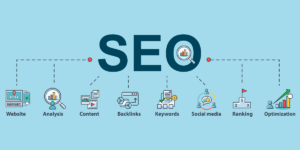SEO is optimizing a website to rank higher in search engine results pages (SERPs). It’s an important part of digital marketing. Click the Visit Website to learn more.
A good SEO strategy focuses on keyword research and the user’s intent. It also includes technical optimization and tracking SEO performance. SEO is constantly evolving.

Keywords are the words or phrases people type into search engines when they’re looking for something. They’re also referred to as “search terms” in the SEO industry.
A keyword can be one word or a phrase, and it’s important to find keywords that are relevant to your business and customers. If you use the right keywords, they’ll help you connect with your audience and drive traffic to your website.
There are many factors to consider when choosing keywords, including keyword volume, competition, and user intent. The right keywords will give you the best chance of ranking for organic searches and driving traffic long-term. You should also incorporate your keywords into the content on your website, and include them in your metadata tags. Using keywords in the title and meta description of your website helps Google understand what your content is about and how it might fit with user search queries.
Keyword research is essential to seo because it shapes your content strategy and helps you create relevant, helpful, high-quality content for users. It also helps you understand what your competitors are doing, so you can stay ahead of them and be more effective in delivering value to your audience.
A good starting point for finding keywords is to enter your competitor’s websites into a keyword tool, such as Ahrefs. This will give you a list of all the related keywords that they are targeting. You can then use this data to make informed decisions about which keywords you want to target.
You should always mix head terms with long-tail keywords. Head terms are short, competitive, high-volume keywords, like “sound design.” Long-tail keywords are longer, more conversational phrases that show user intent and have lower competition. For example, “foley artist for video games” is a long-tail keyword that can be used to attract targeted traffic to your site.
Another way to find keywords is to use a thesaurus. It’s free, and it can provide you with a list of synonyms that relate to your ideal word or phrase. You can even use a thesaurus in your browser to help you find the perfect word for your next blog post.
Content
Content is the most important aspect of SEO, as it helps you rank higher in search results. But it isn’t just any content – it needs to be high-quality, relevant, and engaging. To achieve this, you must invest in keyword research, create valuable content, and do on-page SEO optimization. These are all essential components of a successful SEO strategy.
The best way to achieve this is by creating long-form content, which provides in-depth analysis and insights into a particular topic. This type of content can help you establish yourself as a thought leader in your industry and increase your visibility. It is also more shareable than short-form content, so it can help you drive more traffic to your website.
A great example of long-form content is an infographic, which is a visual representation of complicated data. These are incredibly popular with social media users and can be shared widely, which can boost your visibility and search rankings. Another benefit of creating long-form content is that it can help you improve your website’s user experience. This is important because search engines use user-behavior data to determine which websites are most relevant to the users’ searches.
It is also important to keep in mind that search engines prioritize quality content, which means that your content should be informative and readable. You should also make sure that your content is unique and not duplicated elsewhere. This will help you to avoid penalty from Google for duplicate content and ensure that your content is ranked higher in search results.
SEO-fit content should be well-written, easy to read, and free of grammatical errors. It should also be unique and provide value to your audience. It should also be up-to-date, as search engine algorithms change frequently. Finally, it should be easy to find. This includes using the right keywords, writing a compelling title, and including meta descriptions.
Whether you are a small business owner or an established brand, it is important to take the time to create and optimize your content. Without the right content, you won’t be able to attract potential customers and grow your business.
Link building
Link building is a crucial aspect of SEO, and it involves getting other websites to link to your pages. This increases your page’s authority and improves search engine rankings. However, it’s important to note that link building isn’t just about increasing the number of links – it’s also about creating quality content that other people will want to share.
There are a few different types of link-building techniques. Some involve manually adding a link to another website, while others involve asking for links. Some of these strategies are considered spamming and can damage your reputation. Others are more effective, such as writing a guest post on a relevant blog or participating in forums or Q&A sites. In general, it’s best to stick with natural link-building methods that will give you a competitive advantage.
One important factor when choosing a link-building strategy is to determine what kind of content your target audience needs. This will help you create a more targeted content plan. For example, if you’re targeting technology blogs, it’s best to write long-form articles that provide valuable information for the reader. This will make it more likely that the reader will share your article with their friends and followers.
The next step is to identify potential link partners. This can be done by conducting a Google search and finding sites that are relevant to your industry or niche. Once you’ve identified a few potential partners, you can start reaching out to them. However, before you contact anyone, it’s important to know what their Domain Authority and Brand Authority are. Domain Authority is a ranking tool that measures the strength of a website. Brand Authority is a measurement of how well a company is known and recognized.
While the future of SEO is unknown, it’s clear that link-building is here to stay. It will always be a critical part of any SEO strategy, but it’s important to remember that quality over quantity is key. If you do it right, link-building can help you achieve long-term success. Just be sure to avoid using black-hat tactics, which can damage your site and hurt your business in the long run.
Analytics
SEO analytics is the process of collecting and analyzing data to help marketers make more informed decisions about their SEO strategy. This data can be used to improve search engine optimization and increase website traffic and conversions. Analytics can also help identify areas of the website that need improvement.
There are a number of different tools available for tracking SEO metrics, but many marketers use Google Analytics (GA) in combination with other tools. These tools can be used to track and visualize important SEO metrics, such as organic traffic, keyword ranking, and conversions. Metrics are quantifiable values, while KPIs are measurable goals.
One of the most important SEO metrics is domain authority, which is a measurement of how well a domain or web page is likely to rank on search engines. This metric is calculated using a variety of factors, and it is an essential part of any SEO campaign. It is also referred to as website authority or domain quality.
Another important metric to track is the number of visitors to your website. This metric can be tracked using various tools, such as Google Analytics and Moz’s Open Site Explorer. By understanding where your visitors are coming from, you can optimize your content to attract more qualified leads.
In addition to tracking SEO metrics, you should also be monitoring your website for errors and problems. If you find any issues, it is important to act quickly. This can help you save time and money in the long run. For example, you should check for problems like broken links or site speed issues.
It is important to set up SEO goals that align with your business objectives. These goals can be as simple as a purchase or completing a form. These goals will help you measure the success of your SEO efforts. This will give you a better idea of what is working and where improvements need to be made.
SEO is a constantly evolving process. You must stay up-to-date with the latest trends and changes in search engine algorithms, user behavior, and your competitors. To get the most out of your SEO campaign, you need to understand how your strategies are performing over time. Without this information, your SEO efforts could be based on guesswork.
